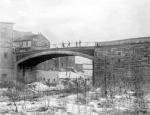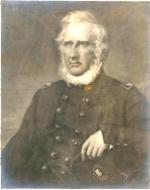![header=[Marker Text] body=[An integral part of the National Road, this was the first metal arch bridge in the United States, built 1836-39. Replacing several earlier bridges on this site, including an 1809 Finley suspension bridge, this 80-foot span was built of cast iron by the U.S. Army Corps of Engineers. Capt. Richard Delafield and Lieutenant George W. Cass oversaw construction] sign](http://explorepahistory.com/kora/files/1/10/1-A-2BB-139-ExplorePAHistory-a0k2a9-a_450.jpg)
Mouse over for marker text
Name:
Dunlap's Creek Bridge
Region:
Laurel Highlands/Southern Alleghenies
County:
Fayette
Marker Location:
At bridge, Market Street, Brownsville
Dedication Date:
November 29, 1991
Behind the Marker
Pennsylvanians used iron for a wide variety of purposes in the eighteenth and early nineteenth centuries. During the early nineteenth century they developed iron structural shapes for buildings and bridges. William Strickland introduced iron structural pieces in buildings when he designed the Chestnut Street Theater in Philadelphia, constructed 1820-1822. This building featured three stands of cast-iron columns that supported balconies and the ceiling. Subsequent architects and engineers expanded the use of iron structural members in buildings, particularly during the 1850s and 1860s.
The Dunlap's Creek Bridge proved the feasibility of using iron structural shapes in bridges. It was at least the fifth bridge to span Dunlap's Creek between Brownsville and Bridgeport. The previous wooden bridge, erected in 1825, had deteriorated greatly by 1832. The wooden bridge carried considerable traffic moving along the Cumberland Road, constructed during the 1810s between Cumberland, Maryland and Wheeling, present-day West Virginia. Because the Cumberland Road was a federally sponsored project, the Army Corps of Engineers had responsibility for repairing the road, including bridges. In the mid-1830s the Army Corps of Engineers took on the task of replacing the wooden bridge.
Captain Richard Delafield led the Army Corps of Engineers contingent assigned to build a new bridge. Delafield recommended to superiors that the new bridge be constructed of iron. British bridge builders had adopted iron during the late eighteenth century, but Delafield was the first to push for an iron bridge in the United States. At the time stone was a common bridge material, but he could not find suitable stone locally.
Delafield also preferred iron to wood, the other common bridge material, because wood was susceptible to decay and fire. In addition, Brownsville had a number of foundries that could cast iron parts for the bridge. Construction began in 1836, and, by 1837, foundries cast more than 300,000 pounds of iron. Traffic started crossing the bridge in 1838 and final details of the bridge, such as railings, were finished a year later.
Although the new bridge demonstrated the feasibility of making iron bridges, bridge builders erected few more metal arch bridges until the late nineteenth century. Metal arch bridges were more difficult to design and erect than metal truss bridges were, so after the Dunlap's Creek Bridge opened, bridge engineers and builders moved toward constructing metal truss bridges. The transition from stone and wooden bridges to iron truss bridges began in the 1840s. As ironworks such as the Phoenix Iron Company began mass manufacturing iron structural shapes in the 1860s, the cost of metal truss bridges declined, facilitating the spread of these bridges. By the late nineteenth century, when bridge builders started erecting more metal arch bridges, steel structural members were replacing iron in the construction of bridges.
Phoenix Iron Company began mass manufacturing iron structural shapes in the 1860s, the cost of metal truss bridges declined, facilitating the spread of these bridges. By the late nineteenth century, when bridge builders started erecting more metal arch bridges, steel structural members were replacing iron in the construction of bridges.
The Dunlap's Creek Bridge stands today as a testament to iron's durability. Engineers analyzed the Dunlap's Creek Bridge iron in 1921 when sidewalks were added to the flanks of the bridge. The analysis found that the bridge had deteriorated very little and was nearly as rust-resistant as iron manufactured in 1921. The bridge has since stood the test of decades of motorized traffic, a heavier burden than the horse-drawn wagons that had trundled along the Cumberland Road.
The Dunlap's Creek Bridge proved the feasibility of using iron structural shapes in bridges. It was at least the fifth bridge to span Dunlap's Creek between Brownsville and Bridgeport. The previous wooden bridge, erected in 1825, had deteriorated greatly by 1832. The wooden bridge carried considerable traffic moving along the Cumberland Road, constructed during the 1810s between Cumberland, Maryland and Wheeling, present-day West Virginia. Because the Cumberland Road was a federally sponsored project, the Army Corps of Engineers had responsibility for repairing the road, including bridges. In the mid-1830s the Army Corps of Engineers took on the task of replacing the wooden bridge.
Captain Richard Delafield led the Army Corps of Engineers contingent assigned to build a new bridge. Delafield recommended to superiors that the new bridge be constructed of iron. British bridge builders had adopted iron during the late eighteenth century, but Delafield was the first to push for an iron bridge in the United States. At the time stone was a common bridge material, but he could not find suitable stone locally.
Delafield also preferred iron to wood, the other common bridge material, because wood was susceptible to decay and fire. In addition, Brownsville had a number of foundries that could cast iron parts for the bridge. Construction began in 1836, and, by 1837, foundries cast more than 300,000 pounds of iron. Traffic started crossing the bridge in 1838 and final details of the bridge, such as railings, were finished a year later.
Although the new bridge demonstrated the feasibility of making iron bridges, bridge builders erected few more metal arch bridges until the late nineteenth century. Metal arch bridges were more difficult to design and erect than metal truss bridges were, so after the Dunlap's Creek Bridge opened, bridge engineers and builders moved toward constructing metal truss bridges. The transition from stone and wooden bridges to iron truss bridges began in the 1840s. As ironworks such as the
The Dunlap's Creek Bridge stands today as a testament to iron's durability. Engineers analyzed the Dunlap's Creek Bridge iron in 1921 when sidewalks were added to the flanks of the bridge. The analysis found that the bridge had deteriorated very little and was nearly as rust-resistant as iron manufactured in 1921. The bridge has since stood the test of decades of motorized traffic, a heavier burden than the horse-drawn wagons that had trundled along the Cumberland Road.








